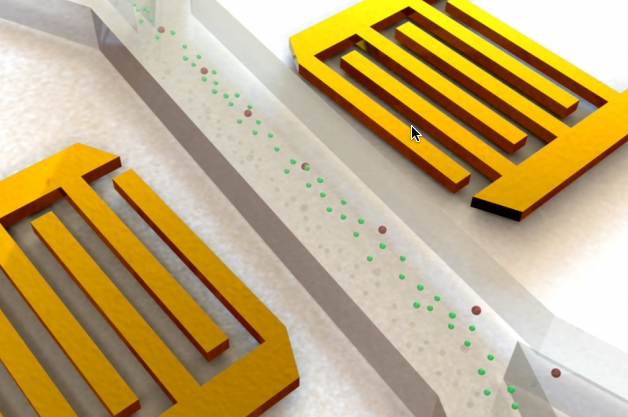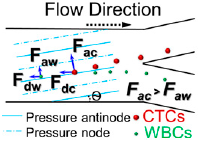Using sound waves to detect rare circulating cancer cells
April 8, 2015

As a mix of cancer cells (red) and white blood cells (green) flows through the microfluidic channel, sound waves from the transducers located on both sides of the channel guide them into separate channels, allowing the rare cancer cells to be moved to the right and isolated (credit: the researchers)
A team of engineers from MIT, Penn State University, and Carnegie Mellon University is developing a novel way to isolate cancer cells that circulate in the bloodstream: using sound waves to separate them from blood cells.
Cancer cells often break free from their original locations and circulate through the bloodstream, allowing them to form new tumors elsewhere in the body.
Detecting these cells could give doctors a new way to predict whether patients’ tumors will metastasize, or monitor how they are responding to treatment, but finding these extremely rare cells has proven challenging because there might be only one to 10 such cells in a 1-milliliter sample of a patient’s blood.
Their new cell-sorting device is 20 times faster than the original version that they first reported last year, approaching the speed that would be necessary to make it useful for testing patient blood samples. The researchers have also demonstrated that the device can successfully capture circulating tumor cells from patient samples, which could enable many clinical applications as well as fundamental research on how these cells escape from their original tumor site.
Ming Dao, a principal research scientist in MIT’s Department of Materials Science and Engineering; Subra Suresh, president of Carnegie Mellon and, at MIT, the Vannevar Bush Professor Emeritus of Engineering and a former dean of engineering; and Tony Jun Huang, a professor of engineering science and mechanics at Penn State, are senior authors of a paper describing the device in the Proceedings of the National Academy of Sciences the week of April 6.
Gentle cell separation

Schematic of the working mechanism behind tilted-angle standing surface acoustic waves-based cell separation. The direction of the pressure nodes and pressure antinodes were established at an angle of inclination (θ) to the fluid flow direction inside a microfluidic channel. Larger circulating tumor cells (CTCs) experience a larger acoustic radiation force (Fac) than white blood cells (WBCs). (credit: Peng Li et al./PNAS)
KurzweilAI has reported on several cancer-cell-sorting techniques. Most existing cell-sorting technologies require tagging cells with chemicals or exposing them to strong mechanical forces that may damage them, according to the MIT/Penn State/Carnegie team.
To sort cells using sound waves, which offer a gentler alternative, the researchers built microfluidic devices with two acoustic transducers, which produce sound waves, on either side of a microchannel.
When the two waves meet, they combine to form a standing wave (a wave that remains in constant position). This wave produces pressure nodes, or lines of low pressure.
Because the sound waves are tilted so they run across the microchannel at an angle, each cell encounters several pressure nodes as it flows through the channel. As cells encounter each node, they are pushed further to the side of the channel; the distance of cell movement depends on their size and other properties, such as compressibility.
In the previous study, the researchers were able to separate cancer cells from red and white blood cells, but the sample flow rate through the device was only 1 to 2 microliters per minute. At that rate, it would take more than 50 hours to process a typical patient sample of about 6 milliliters.
The new version of the device has a working flow rate about 20 times faster, allowing it to process a patient sample in about five hours.
To achieve this, the researchers used computer modeling of cell trajectories, confirmed by experimentation, to adjust some of the device’s other features, including the tilting angle — the angle at which the sound waves strike the channel — and the distance over which the cells are exposed to sound waves.
Rare cells detected
The researchers tested the new acoustic device with samples consisting of a mix of cancer cells and white blood cells grown in the lab. In these studies, they were able to isolate at least 83 percent of the cancer cells from samples that had as few as one cancer cell per 100,000 white blood cells.
The device also performed well in tests of blood samples from three breast cancer patients. From those samples, the researchers isolated one, eight, and 59 tumor cells, respectively; the first sample was from a patient who was responding very well to treatment, and therefore had few tumor cells circulating.
Their results were similar to those from a commercially available device that can sort cancer cells; however, that device damages cells so they are not viable for further studies, Dao says. In contrast, the acoustic technique is very mild and does not require the cells to be tagged with magnetic beads, antibodies or any other molecules, so they are ideal for further analyses once isolated.
“With further improvements in cell throughput, this work could offer a useful new tool, for both basic research into the complex topic of circulating tumor cells and for clinical assessment of different types of cancer,” Suresh says.
The new system’s success in sorting patient samples represents a “significant advance” over the team’s original device, says Taher Saif, a professor of mechanical science and engineering at the University of Illinois at Urbana-Champaign who was not part of the research team. “Now one can imagine a product that could be implemented based on the design they have come up with,” Saif says.
The researchers are now working on further improving the device’s flow rate, as well as making it more robust and cost-effective.
The research was funded by the National Institutes of Health, the National Science Foundation, and the Penn State Center for Nanoscale Science.
Melanie Gonick/MIT | Learn how the researchers’ novel device uses sound waves to separate rare circulating tumor cells from blood cells
Abstract of Acoustic separation of circulating tumor cells
Circulating tumor cells (CTCs) are important targets for cancer biology studies. To further elucidate the role of CTCs in cancer metastasis and prognosis, effective methods for isolating extremely rare tumor cells from peripheral blood must be developed. Acoustic-based methods, which are known to preserve the integrity, functionality, and viability of biological cells using label-free and contact-free sorting, have thus far not been successfully developed to isolate rare CTCs using clinical samples from cancer patients owing to technical constraints, insufficient throughput, and lack of long-term device stability. In this work, we demonstrate the development of an acoustic-based microfluidic device that is capable of high-throughput separation of CTCs from peripheral blood samples obtained from cancer patients. Our method uses tilted-angle standing surface acoustic waves. Parametric numerical simulations were performed to design optimum device geometry, tilt angle, and cell throughput that is more than 20 times higher than previously possible for such devices. We first validated the capability of this device by successfully separating low concentrations (∼100 cells/mL) of a variety of cancer cells from cell culture lines from WBCs with a recovery rate better than 83%. We then demonstrated the isolation of CTCs in blood samples obtained from patients with breast cancer. Our acoustic-based separation method thus offers the potential to serve as an invaluable supplemental tool in cancer research, diagnostics, drug efficacy assessment, and therapeutics owing to its excellent biocompatibility, simple design, and label-free automated operation while offering the capability to isolate rare CTCs in a viable state.